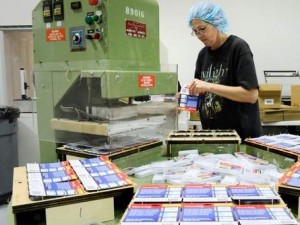Sarasota’s WoundSeal trying to be next Band-Aid
Published: Monday, September 10, 2012 at 1:00 a.m.
Last Modified: Saturday, September 8, 2012 at 4:08 p.m.
MANATEE COUNTY – When Dr. James Patterson cut his hand while doing research on a blood-thinning medication in his Sarasota lab, the wound was serious enough to warrant a trip to the emergency room.
En route, however, he noticed the potassium salt powder he had accidentally spilled on the cut had started to clot the blood coming out. As someone who took a blood thinner, Patterson knew that was not supposed to happen.
Patterson and his research partner, John “Alf” Thompson, immediately sensed they were onto something.
After more investigation, the duo concluded they had stumbled on a substance that sealed wounds better than adhesive bandages or gauze.
From that discovery, what could be called Southwest Florida’s penicillin moment, the pair approached Charles Entenmann, Thomson’s father-in-law. Entenmann had retired to Florida after selling the cake-and-pastry company that bears his family’s name.
Like Patterson, he, too, took blood thinners and understood what the brown powder could mean.
Entenmann decided to bankroll a company to develop it.
The result was Biolife LLC, founded on Tallevast Avenue in 1999.
But while Patterson and Thompson had the research, and Entenmann the millions of dollars needed to bring the powder to market, just about everything else was lacking.
“We didn’t have a product, didn’t know who to sell it to, didn’t have packaging and didn’t know where the market was,” said Tim Kelly, a Biolife executive vice president who joined the company a decade ago.
Nor would development be fast moving. It would take a decade for the company’s WoundSeal product to hit the local market, beginning in 48 Walgreen’s stores.
Today, Biolife employs about 30 at its headquarters and manufacturing plant, located off U.S. 301 just north of University Parkway.
Its WoundSeal is sold in more than 16,000 retail outlets nationwide, mostly in Walgreen’s and CVS drug stores, and it is used by 300 of the U.S.’ 6,000 hospitals, and by teams in the National Hockey League and Major League Baseball.
The 13-year-old company has been recognized as a “second stage” growth firm by a statewide program that also labelled it one of the Florida Companies to Watch.
Biolife also has received coveted technical support from the Florida Economic Gardening Institute, a program based at the University of Florida in Gainesville.
Though the company has yet to achieve the kind of retail success on a national scale that would make WoundSeal the next Band-Aid, the company believes it is now poised to take advantage of a specific growth market and the aging of America.
Powder, plus pressure
In the lobby of its 22,305-square-foot headquarters, which company managers acquired for $1.53 million, there is a large wall with a big “WHY” surrounded by testimonials from people who have been helped by WoundSeal.
They include a hemophilia patient who had been bleeding for 24 hours, a child suffering from chronic nosebleeds, a leukemia patient whose life was saved when he had profuse oral bleeding during surgery.
WoundSeal comes in individual packages. Stanching a cut is as simple as applying the powder and pressing on it.
“We say, ‘Powder plus pressure creates an instant scab,'” said Andrew McFall, the company’s vice president of marketing.
The “scab” is airtight and so water resistant that users can go swimming or take a shower an hour after application. In time, the wound underneath heals, and the WoundSeal scab falls off.
“It bonds with the protein in blood to clot,” said Dr. Louis Guzzi, who is based at Florida Hospital, in Orlando, and is also Biolife’s chief medical officer. “More importantly, it creates an airtight seal for the wound, keeping bacteria out.”
Company officials say it is WoundSeal’s simplicity that makes it so appealing.
That is why, in part, BioLife is targeting seniors who use blood thinners to prevent strokes and heart attacks for future growth.
In all, some 52 million Americans use some form of blood thinners, from low-dose aspirin to pharmaceuticals like Coumadin, Plavix and Warfarin, McFall said.
Alan Brownstein, the president and CEO of the National Blood Clot Alliance, has both a personal and professional interest in WoundSeal. His father, who takes Warfarin, uses it.
“Many are on blood thinners to prevent blood clots and have to deal with nuisance bleeding, and this product takes care of it,” Brownstein said.
He adds that many patients, especially seniors, discontinue taking prescribed blood thinners — despite the increased risk of heart attack — because of nuisance bleeding.
In a study conducted by the makers of Plavix, 11 percent of the drug’s users admitted they stopped taking it within a year of having a stent put in after dealing too long with bleeding.
“WoundSeal helps with that and removes a major obstacle for not taking the meds,” Brownstein said.
Brownstein estimates there are now 2.6 million seniors who suffer from atrial fibrillation, and about half of them take blood thinners.
“In the next 30 years, that number is going to be 12 million,” he said.
Already, Biolife is feeling that impact. Although the privately held company does not release earnings, Kelly said that in 2011 and for the first half of 2012, Biolfe experienced 40 percent growth.
“We’re going up the steep part of the hockey stick now,” Kelly said.
A few setbacks
Biolife has had a few setbacks on the road to going national, however, which has kept total employment frozen for most of the past decade.
Company officials now say they expect to double employment within the next few years.
But that will depend on negotiations with major retailers, which have often stalled. Plans to go into a few chains that appeared promising at first also have not panned out — though the company hopes to begin selling WoundSeal in Target and Walmart next year.
Part of the problem could be one of identity. For years, the product was known simply as “QR,” short for quick relief. But many customers found that confusing, prompting the name change.
Just as confusing, the product in hospitals goes by the name of BioSeal, not WoundSeal.
Marketing and retailer support has been spotty, too. Walgreen’s officials declined, for instance, to discuss WoundSeal beyond acknowledging that their stores sell it.
To combat the confusion and take better control of its brand, Biolife is launching a national marketing campaign aimed at bolstering retail sales.
“We want to get this in the hands of every senior on blood thinners,” McFall said. “We are taking steps now to drive awareness. We want to get over 200 million advertising impressions about WoundSeal this year, using print media and online advertising.”
Dick Fenimore is already sold. The 84-year-old Sarasota retiree began using WoundSeal three years ago.
“It just stops the bleeding,” he said. “It’s faster and seems to work as well or better than any other product like it.”

